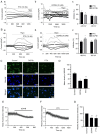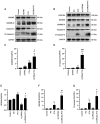Paclitaxel induces pyroptosis by inhibiting the volume‑sensitive chloride channel leucine‑rich repeat‑containing 8a in ovarian cancer cells
- PMID: 37083067
- PMCID: PMC10170489
- DOI: 10.3892/or.2023.8552
Paclitaxel induces pyroptosis by inhibiting the volume‑sensitive chloride channel leucine‑rich repeat‑containing 8a in ovarian cancer cells
Abstract
Pyroptosis is a newly identified form of cell death, morphologically characterized by excessive cell swelling. In the present study, paclitaxel (PTX) combined with platinum were used as first‑line chemotherapy, against ovarian cancer cells by inducing multiple types of cell death. However, it remains unclear whether PTX can induce pyroptosis in ovarian cancer cells. It was recently reported that PTX inhibited chloride channels, an inhibition known to cause cell swelling. In the present study, it was first verified that pyroptosis‑like cell death, as well as cleaved‑caspase‑3 and cleaved‑gasdermin E (GSDME) were induced by PTX in A2780 ovarian cancer cells. PTX inhibited the background‑ and hypotonicity‑activated chloride currents, promoted intracellular chloride ion accumulation, those manifestations are similar to those of the classic volume‑regulatory anion channel (VRAC) blocker, 4‑(2‑butyl‑6,7‑dichloro‑2‑cy-clopentyl‑indan‑1‑on5‑yl) oxobutyric acid (DCPIB). Of note, both DCPIB and the downregulation of VRAC constituent protein leucine‑rich repeat‑containing 8a themselves could not induce persisted cell swelling and pyroptosis‑like phenotypes. However, they could enhance the effects of PTX in inducing pyroptosis‑like phenotypes, such as marked cell swelling, cell membrane rupture and excessive activation of caspase‑3 and GSDME N‑terminal fragment, which ultimately caused marked pyroptosis in A2780 cells. These findings revealed a potential mechanism of PTX and offered new insights into the effects of a synergistical combination of PTX and VRACs blockers in ovarian cancer chemotherapy.
Keywords: chloride channel; ovarian cancer; paclitaxel; pyroptosis.
Conflict of interest statement
The authors declare that they have no competing interests.
Figures






Similar articles
-
ClC-3 promotes paclitaxel resistance via modulating tubulins polymerization in ovarian cancer cells.Biomed Pharmacother. 2021 Jun;138:111407. doi: 10.1016/j.biopha.2021.111407. Epub 2021 Mar 23. Biomed Pharmacother. 2021. PMID: 33765585
-
Chemotherapeutic paclitaxel and cisplatin differentially induce pyroptosis in A549 lung cancer cells via caspase-3/GSDME activation.Apoptosis. 2019 Apr;24(3-4):312-325. doi: 10.1007/s10495-019-01515-1. Apoptosis. 2019. PMID: 30710195
-
Liposomal paclitaxel induces apoptosis, cell death, inhibition of migration capacity and antitumoral activity in ovarian cancer.Biomed Pharmacother. 2021 Oct;142:112000. doi: 10.1016/j.biopha.2021.112000. Epub 2021 Aug 20. Biomed Pharmacother. 2021. PMID: 34426249
-
Medical therapy of advanced malignant epithelial tumours of the ovary.Forum (Genova). 2000 Oct-Dec;10(4):323-32. Forum (Genova). 2000. PMID: 11535983 Review.
-
The Role of Chloride Channels in the Multidrug Resistance.Membranes (Basel). 2021 Dec 28;12(1):38. doi: 10.3390/membranes12010038. Membranes (Basel). 2021. PMID: 35054564 Free PMC article. Review.
Cited by
-
Physiological roles of chloride ions in bodily and cellular functions.J Physiol Sci. 2023 Nov 15;73(1):31. doi: 10.1186/s12576-023-00889-x. J Physiol Sci. 2023. PMID: 37968609 Free PMC article. Review.
-
Pyroptosis and chemical classification of pyroptotic agents.Mol Divers. 2025 Jun;29(3):2765-2782. doi: 10.1007/s11030-024-10987-6. Epub 2024 Sep 24. Mol Divers. 2025. PMID: 39316325 Free PMC article. Review.
-
Phosphorylated IRF3 promotes GSDME-mediated pyroptosis through RIPK1/FADD/caspase-8 complex formation during mitotic arrest in ovarian cancer.Cell Commun Signal. 2025 Jul 1;23(1):306. doi: 10.1186/s12964-025-02322-9. Cell Commun Signal. 2025. PMID: 40597187 Free PMC article.
-
The multifaceted roles of GSDME-mediated pyroptosis in cancer: therapeutic strategies and persisting obstacles.Cell Death Dis. 2023 Dec 16;14(12):836. doi: 10.1038/s41419-023-06382-y. Cell Death Dis. 2023. PMID: 38104141 Free PMC article. Review.
-
Pyroptosis-related gene signature: A predictor for overall survival, immunotherapy response, and chemosensitivity in patients with pancreatic adenocarcinoma.Heliyon. 2023 Nov 28;9(12):e23004. doi: 10.1016/j.heliyon.2023.e23004. eCollection 2023 Dec. Heliyon. 2023. PMID: 38125471 Free PMC article.
References
MeSH terms
Substances
LinkOut - more resources
Full Text Sources
Medical
Research Materials

